Development costs for biopharmaceuticals are, on average, 11 times that of their small molecule counterparts, leading to product costs approximately 22 times higher. While the number of available, lifesaving biologics has significantly increased in recent years, their high costs have contributed to patient inaccessibility and unsustainable pressures on healthcare systems worldwide. Applying advanced digital technologies like artificial intelligence and machine learning to pharmaceutical manufacturing dramatically enhances efficiency, reduces operation expenses, speeds the time to market, and elevates product quality, which are the keys to relieving these cost pressures. These innovations are transformative, reshaping the entire bioprocessing life cycle.
Biopharmaceuticals – Big Potential and Big Costs
With projected overall sales of $516.79 billion in 2024, the biopharmaceutical sector captures over 30% of the overall pharma market and represents the fastest growing sector, with a projected 8.07% compound annual growth rate through 2029.1,2 On a geographic basis, the market is dominated by the United States, followed by Europe and Japan, with the latter exhibiting the highest growth rate.1
While small molecule drugs accounted for 59.9% and biopharmaceuticals just 33.6% of the pharma market in 2020 from a market capitalization perspective, half of the 20 top-selling drugs were based on biologic drug substances, 80% of which were monoclonal antibodies (mAbs).
The expansion of the biopharmaceuticals market is driven by various factors, such as an increase in the elderly population, a surge in the prevalence of chronic diseases like cancer, HIV/AIDS, and diabetes, and an increase in the broader global adoption of biopharmaceuticals. These products offer substantial benefits, including highly effective and potent action, reduced side effects, the potential to cure rather than merely treat symptoms, and the capacity to address unmet medical needs.2,3
On average, it takes 12–13 years for a newly discovered drug candidate to reach the market,4,5 consuming half or more of the patent lifetime, at an average cost of $2 billion.6 In addition, just one or two of every 10,000 molecules successfully enters the market. The development and manufacturing costs of biologics are significantly higher than those for small molecule drugs — about 11 times greater, leading to a daily dose cost approximately 22 times higher.7 The greater cost and complexity of biopharmaceutical manufacturing also limits the savings for biosimilars, which has hindered their adoption and market penetration.9
Facing intense cost pressures and competition, biopharma companies and CDMOs are increasingly looking for ways to streamline process development, accelerate market entry, and minimize batch failures — which can result in revenue losses of tens of millions of dollars per failed batch (currently, up to a 5% failure rate). Any improvements must also adhere to stringent regulations while maintaining quality and mitigating risks in unpredictable operational and clinical settings.
Digitalization offers transformative potential in this landscape. By fostering earlier and more informed decision-making, reducing development time and costs, and enhancing the reliability and efficiency of production processes, digital technologies hold the promise to significantly disrupt biopharmaceutical manufacturing.
The Role of Digitalization to Conquer Biopharmaceutical Manufacturing Challenges
Biopharmaceuticals, each of which can consist of up to 25,000 atoms, are derived from highly specific, genetically modified microorganisms or cell lines. The development of these drugs involves complex processes that require the evaluation of hundreds to thousands of potential parameters, from choosing the right microorganism to optimizing bioreactor operation and purifying the product to eliminate impurities that could lead to adverse effects.
To achieve more cost-effective and efficient process development resulting in robust, reliable, and cost-efficient processes, the main engineering challenges are to (1) reduce the efforts in the wet lab required to generate decision support for efficient process development and scale-up, (2) establish a robust monitoring and control scheme to manage and minimize deviations and inconsistencies in scaled processes, and (3) ensure systematic documentation and storage of all generated data and knowledge to support ongoing production, meet regulatory documentation requirements, and facilitate regulatory filings (Figure 1).
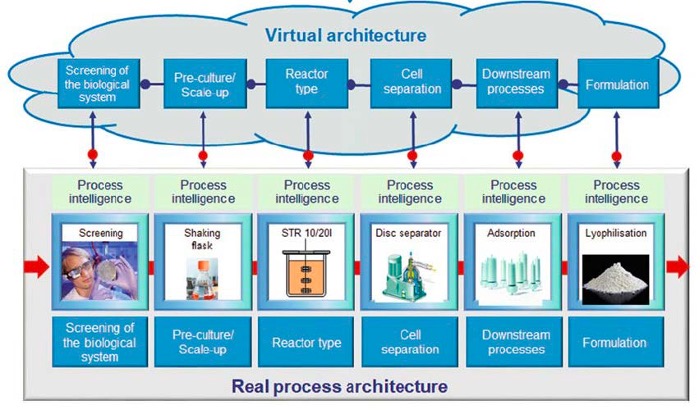 Figure 1. Information content during life cycle of biologics process development
Figure 1. Information content during life cycle of biologics process development
Indeed, during process development and manufacturing, large quantities of data are generated about the biomolecule itself, as well as the upstream and downstream manufacturing processes involved in its production, purification, and final product formulation. This generation of process intelligence, however, typically occurs in specialized departments by different distinct and different expert teams as the candidate moves from early-phase process development, where major decisions on process design modes and parameters are made, to late-stage development, where the focus is on verification of process performance and robustness at large scale.
Notably, even after as many as several years of process development and scale-up, the majority of biopharma companies (>70%) experience manufacturing bottlenecks.11 This issue can be partially attributed to a low level of automation, allowing room for numerous sources of human error, and limited data digitalization, standardization, and central storage of information.12
While most pharmaceutical companies have initiated digital transformation, only a few have achieved a high level of digital maturity, featuring extensive automation, system integration, and data sharing across their operations. Significant quantities of relevant data are still captured on paper or in basic Excel spreadsheets. Process monitoring often relies on offline analytics requiring manual manipulation and data entry, precluding real-time feedback on process performance. Even within the same company (let alone multiple companies), different teams may use different software, impeding effective data sharing and creating data silos. If data analysis software is employed, often basic correlation analysis and relatively simple linear regression techniques are used to understand and support process development and manufacturing operations.
Despite the growing acceptance and use of digital technology in the biopharmaceutical industry, there remains considerable untapped potential to leverage digitalization for tangible business benefits.
Key Technologies Driving Digital Transformation
A recent survey of biopharmaceutical industry executives revealed that 75% of respondents routinely use databases for data storage and statical analysis methods, such as design of experiments (DoE) and multivariate analysis, but only half indicated that they applied nonlinear analysis methods such as machine learning (ML) and hybrid models.14 Digital twins were least established for the survey respondents, with less than 30% noting access to this digital technology. Interestingly, nearly the same percentage of respondents viewed both multivariate analysis, which has been around for 30 years, and new digital technologies to be disruptive, suggesting still limited use of the former, as well as limited understanding of the great benefits of the new state-of-the-art AI technologies compared with established DoE approaches.
In general, survey participants were currently focused on data storage and organization, with considerably less than 50% leveraging centralized data analytics and model generation. In addition, the survey revealed that there are likely significant quantities of data not being used for analysis purposes, perhaps because the data is stored in unstructured reports and/or on paper. Notably, a substantial number of companies are undertaking digitalization projects in-house, with different activities being outsourced to expert vendors.
It is worth noting that in 2021, the FDA provided a motivating vision of an industry 4.0–driven future for the pharma sector, highlighting the essential technological building blocks that need to be developed to realize the vision (Figure 2).14 Significant effort has been placed on creating centralized process databases in the past five years. A key objective is the consolidation of all generated data in a standardized and centralized database that is consistently updated as new data become available. Such a database must be designed to allow for collection and storage of different types of data across the full development cycle for the types of biomolecules developed and produced by the manufacturer. In addition, the database solution should be scalable to accommodate growing quantities of data as laboratory and commercial processes are increasing automated, such as with the use of robotics for sample preparation for rapid analyses, mini/microbioreactors for rapid process screening, and online monitoring with feedback loops to allow for real-time adjustment of process feeds and operating parameters in response to changing conditions.
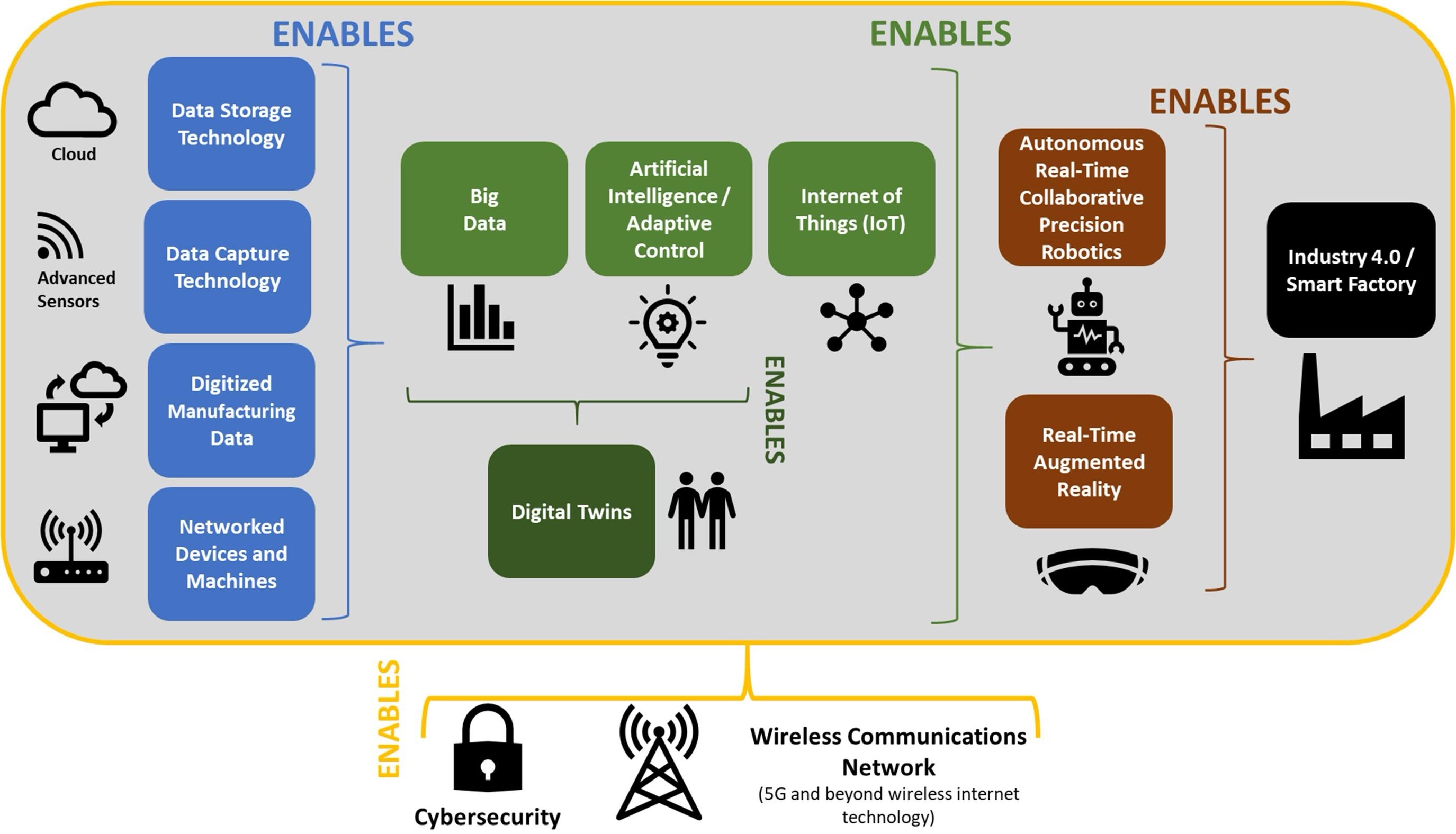 Figure 2: Enabling technologies in an Industry 4.0 smart factory
Figure 2: Enabling technologies in an Industry 4.0 smart factory
Now, online sensors for real-time data capture during bioprocessing are becoming an important industry standard, with data centrally stored and therefore accessible for use in big-data analytics systems. These solutions support simulation generation and are increasingly integrated with other digital tools, such as adaptive control systems, digital twins, and cyber-physical systems like the Internet of Things.13 This paves the way in the coming years to exploit cutting-edge AI technologies to derive value from these data, such as predictive process models for an enhanced understanding of the manufacturing process, as well as the creation of digital twins — comprehensive simulations that optimize pharmaceutical labs and production facilities across all relevant unit operations. All such technologies will be critically evaluated with regard to their potential and technical risks in the highly regulated GMP manufacturing environment. The first movers to exploit such AI technology consistently in their manufacturing life cycle are likely to derive a competitive advantage, which particularly applies for CDMO companies, who are currently an essential element of the main trend in pharma to cut costs.
Already now, first movers were able to test data management and process modeling solutions in parallel without waiting to start the latter until after the first was completed. This allowed them to identify a holistic digital transformation approach, with the benefit that process modeling solutions are much faster to test compared with the more systematic approach required to derive value from an established data management architecture. Combined, these digital solutions facilitate automated monitoring and control, significantly reducing human error and potentially enabling real-time quality understanding and product release. Moreover, centralized data repositories are instrumental in training artificial intelligence (AI)/ML algorithms, fostering innovations that surpass human cognitive capabilities. Collectively, these technologies enhance our understanding of biological processes and support the development of highly efficient, autonomously functioning systems.
Organizational Challenges and Strategies for Digital Transformation
In line with increasing digitization in pharma, the number of digital solutions seeking to create value from the increasing data amount has also been evolving. While some solutions try to embed the bioengineering knowledge, others are trying to use customized ML approaches. The diversity of these digital technologies and their associated challenges (Figure 3) can be overwhelming for biopharma companies beginning their digital transformation journey. A clear digitalization strategy is crucial to ensure that digitalization activities align with the overall business strategy and to tackle specific challenges effectively. For digitalization to truly empower an organization, a holistic approach must be adopted, ensuring that selected digital solutions are integrated across all facets of the business — from research and development to clinical trials, manufacturing, and distribution.
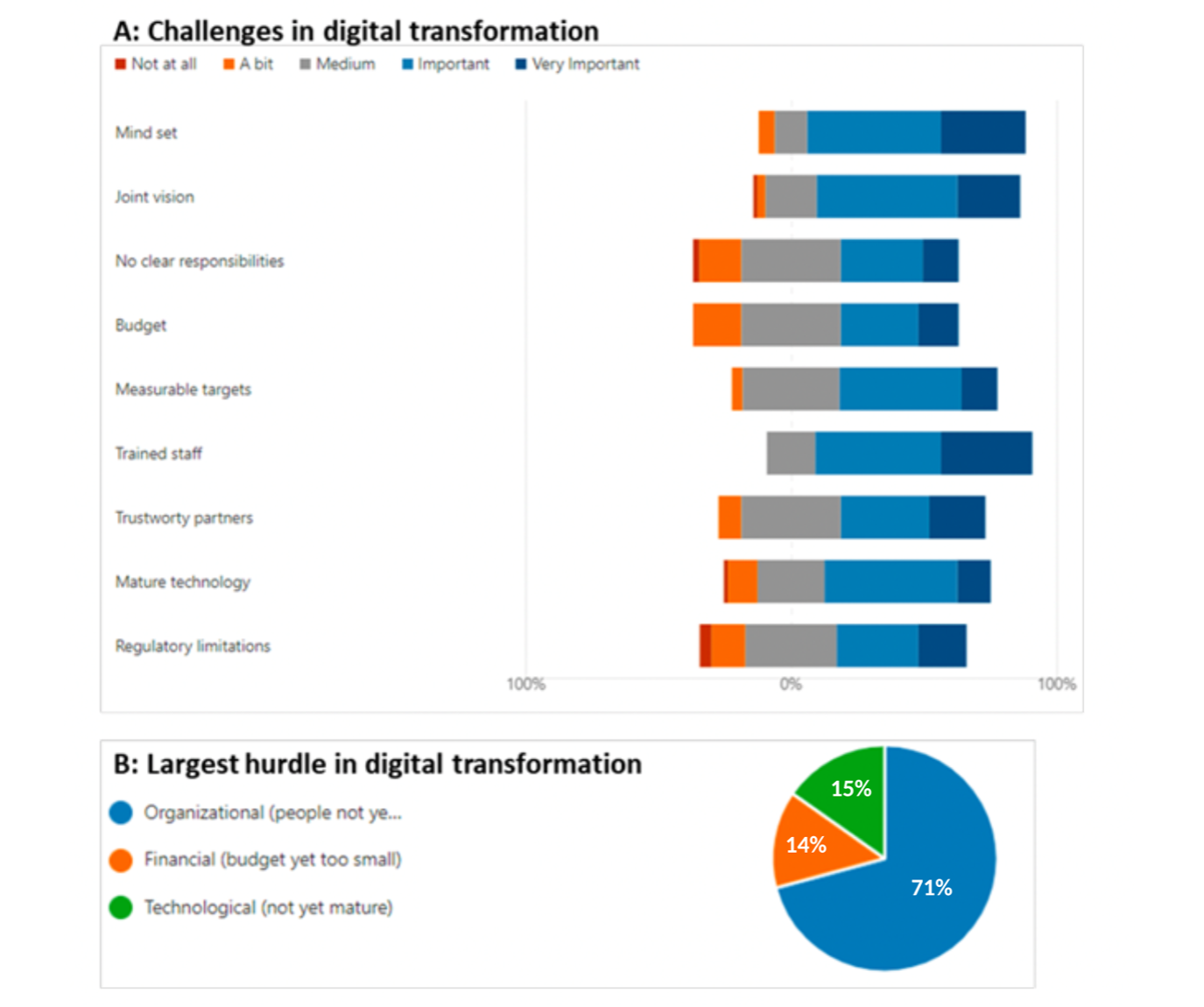 Figure 3. Challenges in digital transformation (quantitative survey)14
Figure 3. Challenges in digital transformation (quantitative survey)14
Such an approach to digitalization requires buy-in across the entire company, which is achieved through cultivation of a digital mindset and culture. A full digital mindset goes beyond understanding basic tools and how to use them to include more advanced competencies and techniques and incorporation of digitalization into daily work activities, decision making, and the leadership culture, which then enable development of trust in digital solutions. Operational agility is also important to allow for new workflows and rapid response to daily challenges. On the other hand, suppliers must assure through well-integratable and interpretable solutions to be attractive for a broad rollout among many stakeholders for whose daily work these solutions have to provide value.
The recruitment of skilled professionals like data scientists, digitally savvy process modeling experts, and IT personnel is vital for driving digital change. While some companies may choose to partially outsource these responsibilities, the importance of internal knowledge management specialists in ensuring the effective use of digital technologies — often overlooked in the pharma industry — cannot be overstated. A main learning from first movers is the ability to identify an optimal setup of digital technologies to embedin their operations based on light house activities, demonstrating the general potential and paving the path to free and train resources to internalize this capability and assure the ability of systematic integration into daily workflows.
Therefore, collaboration between all these digital specialists and the company’s subject matter experts, operators, and decision-makers, including effective integration into teams implementing digitalization projects, is critical. Teams should be dedicated to digital projects and not be sidetracked by other duties. Likewise, internal education programs aimed at enhancing the digital skills of existing staff are fundamental for successful implementation and utilization of these technologies as a commodity in the complex bioprocessing world.
Ongoing communication about the company’s progress on its digitalization transformation journey, including different projects being implemented across the organization and the roles employees will play once digitalization goals are reached, is equally important to overcome the natural resistance of people and organizations to change (Figure 4). Often, employees feel threatened by digitalization due to concerns that their jobs will eventually be eliminated. Most often, however, the goal of digitalization and automation is to make existing staff more effective and productive, not to reduce workforce numbers.
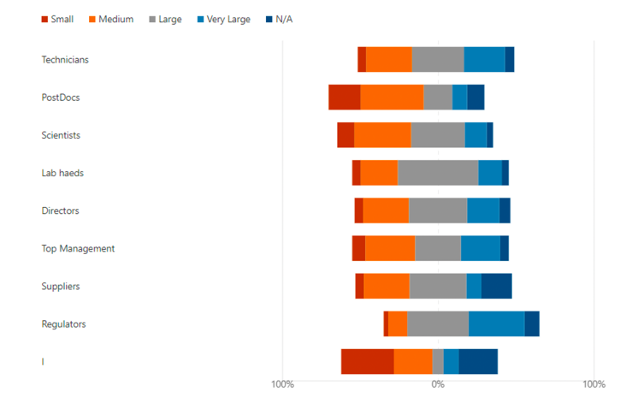 Figure 4. Requirement for mindset change toward digital technologies by different stakeholders (quantitative survey)14
Figure 4. Requirement for mindset change toward digital technologies by different stakeholders (quantitative survey)14
Successful digitalization requires that it be marketed internally as essential to the business and supported by a diverse, cross-functional leadership team. Employees must be educated about the value and use of digital technology, fostering an environment where innovation is routine, and successes and challenges are communicated regularly to maintain engagement and buy-in.
As early as possible, initial success stories should be translated in broadly applicable business cases, for which a continuous return on investment (ROI) measurement should be applied. This will inevitably allow a company to continuously improve, combine, and broadly roll out digital initiatives in accordance with its overall strategy. First movers started to address gains obtained from consistent use of dedicated digital solutions for specific tasks and demonstrated the ability to substantially reduce costs and/or improve process operation and automation abilities. In the coming five years, one can expect that a larger number of pharma companies will be able to enhance their operations based on digital solutions, some of which will offer a clear competitive advantage.
Strong partnerships with digital solution providers and academic institutions are also key. Universities are increasingly embedding digital capabilities into the curricula of bioengineering programs to prepare specialists with strong skills in the lab but also in the quantitative analysis of the lab data. Furthermore, many technology suppliers have emerged from research pursued by academic groups, and ongoing collaborations between these firms and universities can also help influence future educational approaches to process and data science.
In the manufacturing environment, any technology providers must be knowledgeable about the requirements for digital solutions implemented in a GMP environment. Ideally, they are willing to establish long-term relationships that include two-way collaboration to ensure the development of optimal, fit-for-purpose solutions that can then be extensively tested and improved with feedback after use in real-life settings.
Adopting best practices involves creating a comprehensive digitalization roadmap to address change resistance and break down data silos. The digital technologies chosen must address common challenges, be broadly comprehensive, and demonstrate clear benefits for daily operations, beginning with incremental innovations and building toward disruptive changes. A well-defined digitalization strategy, aligned with broader biopharma manufacturing goals, should be continuously refined and adequately funded. Business cases built on real data that project contributions to competitive advantages should be shared widely and promptly to ensure ongoing support. This strategy should encompass three main verticals: establishing a robust digital infrastructure; leveraging advanced analytics like machine learning as broadly useful platforms within the full enterprise; and assuring the impact of digitalization is well understood and supported by dedicated staff and ambassadors within the organization.
Future Outlook with Digitalization at the Heart of Operational Excellence
Ideally, digital transformation in biopharma should be embraced holistically, extending from drug screening during the discovery phase to optimizing clinical trials and manufacturing processes, thus covering the entire value creation chain of a drug's life cycle (Figure 5). Importantly, digital technologies leveraging massive amounts of relevant data allow for more informed decision-making without the need for extensive physical experimentation, thereby enabling better decisions much earlier than previously possible at all stages of development.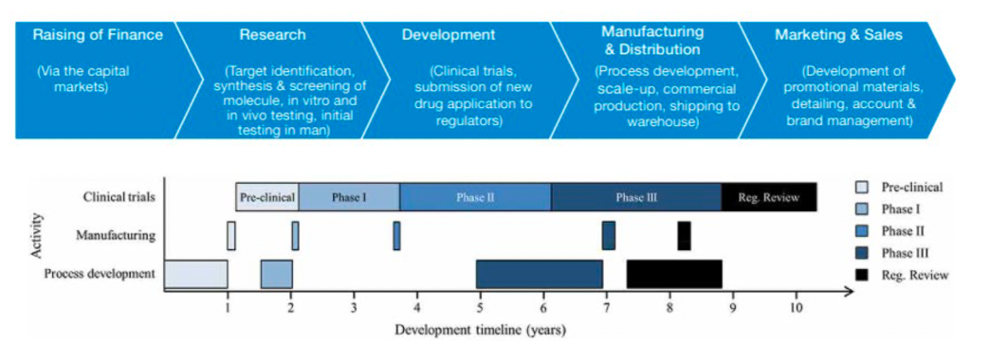 Figure 5. (Top) The pharmaceutical value creation chain; (Bottom) Timeline of new (bio)pharmaceutical development activities
Figure 5. (Top) The pharmaceutical value creation chain; (Bottom) Timeline of new (bio)pharmaceutical development activities
The goal is to combine the various digital technologies to enable intelligent, precise, real-time, and collaborative operation and automation of biomanufacturing activities. Such "smart factories" would employ wireless networks and robust cybersecurity measures. Achieving this vision requires broad collaboration across a digital ecosystem, as no single supplier can provide all necessary capabilities. This ecosystem will likely evolve into a distributed peer-to-peer network, featuring a digital platform that enables seamless interactions between pharmaceutical companies and other entities in the business network through data and product exchanges, as well as technical support services.15 Nonetheless, given the entry barrier into the regulated pharma industry, first-mover suppliers and broadly connectable solutions to well established hardware components and their digital interfaces will have a strong competitive advantage.
For sustained progress (Figure 6), companies must establish a digital pathway where all bioprocess development and manufacturing data are digitized, standardized, and centrally stored. Model-based technologies will then enhance decision-making about process design, operation, and technology transfer. Automation of the optimized processes with real-time monitoring and control will improve efficiency, productivity, and robustness while reducing risks. Using standardized hardware and software ensures connectivity and communication across all operations and activities, including material sourcing, maintenance, process development, analytics, regulatory compliance, and the scheduling and implementation of all unit operations.
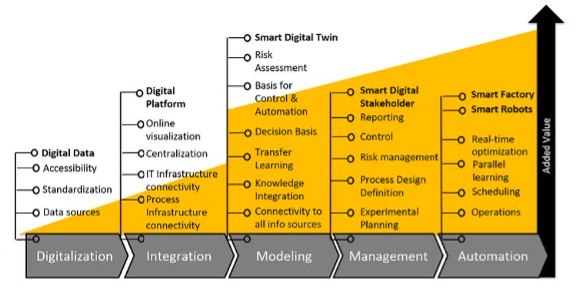 Figure 6. Digital value creation chain in pharma manufacturing
Figure 6. Digital value creation chain in pharma manufacturing
Digitalization also presents a cultural challenge, requiring the formation of new teams and mindsets. This dynamic path will be driven by digital natives advancing into management roles, rapid technological evolution, new market entrants, and mergers and acquisitions in the pharma sector. Leaders in digital innovation will be pharmaceutical and CDMO companies that can effectively test, qualify, and implement digital technologies through partner-driven customization initiatives and have built an internal ecosystem of suppliers that integrate all necessary technologies into a standardized workflow. Their digital strategies will directly link to key business objectives, such as revenue models and new market opportunities, and be adaptable to feedback and ongoing innovation, thus maximizing investment returns. In the coming 2–3 years, we can expect several of the first movers to demonstrate a measurable ROI on the investment into every of their digital initiatives and technologies, as well as their integration exploitation.
Digital transformation represents a significant shift in the underlying business model of biopharma manufacturing, offering the potential to fundamentally rethink and restructure operational methods. This shift is particularly crucial for the success of personalized medicine and advanced therapies like cell and gene therapies, which demand customized, rapid production processes for smaller patient groups. Digital technologies will be vital in achieving efficient manufacturing processes, enhancing product quality, and reducing costs and risks, ultimately benefiting all stakeholders in the pharmaceutical value chain, from suppliers to patients.
Conclusion: The Imperative for Digital Transformation in Biopharma
Digital technologies are not just improving but revolutionizing pharmaceutical manufacturing, marking a shift toward significant efficiency improvements, cost reductions, and enhanced product quality. The urgency to integrate these innovations stems from their profound impact across the entire biopharma value chain — from dramatically reducing risks and enhancing stability in supply chains to elevating patient safety and treatment efficacy. The call to action for industry leaders is clear: invest in digital transformation not as a mere enhancement but as an industry imperative. The future leaders of the biopharma sector will be those who enable ongoing therapeutic innovation benefiting patients in need while leveraging advanced technologies to develop and manufacture drugs in a manner that is financially sustainable.
References
1. Biopharmaceutical Industry Size & Share Analysis – Growth Trends & Forecasts (2024–2029). Mordor Intelligence. 2024.
2. Darby, Nigel. “Trends in the biopharmaceutical market: Are you ready for the future of manufacturing?” Bioprocess Online. 19 Jan. 2018.
3. Sokolov, Michael. Data- and Knowledge-driven Computational Tools for the Process Development of Biopharmaceuticals (Issue 24372). ETH Zurich. 2017.
4. Beall, R. F., Hwang, T.J. and Kesselheim, A.S. “Pre-market development times for biologic versus small-molecule drugs.” Nature Biotechnology. 37:708–711 (2019).
5. “The Pharmaceutical Industry in Figures.” European Federation of Pharmaceutical Industries and Associations (EFPIA) Brussels Office. EFPIA. 2021.
6. DiMasi, J.A., Grabowski, H.G. and Hansen, R.W. “Innovation in the pharmaceutical industry: New estimates of R&D costs.” Journal of Health Economics. 47: 20–33 (2016).
7. Gooch, J., Cordes, F., Bressau, F. and Berk, P. What Does—and Does Not—Drive Biopharma Cost Performance. 2017.
8. Johnson & Johnson And Crucell Reach Agreement On Intended Public Offer Of Euro 24.75 Per Ordinary Share Of Crucell. Johnson & Johnson. 8 Oct. 2010.
9. Makurvet, F.D. “Biologics vs. small molecules: Drug costs and patient access.” Medicine in Drug Discovery. 9: 100075 (2021).
10. David, E., Tramontin, T. & Zemmel, R. “Pharmaceutical R&D: the road to positive returns.” Nature Reviews Drug Discovery. 8: 609–610 (2009).
11. Langer, E. “Breaking the Biotech Bottleneck.” Pharma Manufacturing. 7 Jan. 2013.
12. Sokolov, M., Feidl, F., Morbidelli, M. and Butté, A. “Big data in biopharmaceutical process development: Vice or virtue?” Chimica Oggi/Chemistry Today. 36” 26–29 (2018).
13. Arden, N.S. et al. “Industry 4.0 for pharmaceutical manufacturing: Preparing for the smart factories of the future.” International Journal of Pharmaceutics. 602: 120554 (2021).
14. Sokolov, Michael. Digital transformation in pharma manufacturing: A qualitative and quantitative assessment of organizational, technological and business drivers and challenges. Master’s Thesis, University of St. Gallen School of Management, Economics, Law, Social Sciences, International Affairs and Computer Sciences. 4 Jan. 2022.
15. Lager, T. et al. “Digital Transformation in the Swedish Process Industries: Trends, Challenges, Actions.” Journal of Business Chemistry. 17: 17–31 (2020).

